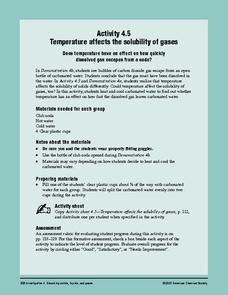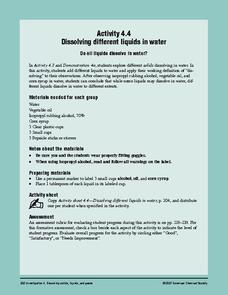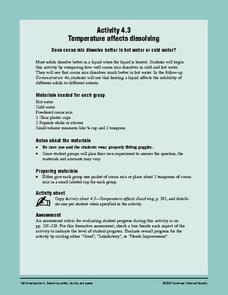American Chemical Society
Temperature Affects the Solubility of Gases
Dare your class to drive dissolved carbon dioxide out of carbonated liquid at different temperatures to discover if there is a difference in rate. To make this experiment more sound, have explorers use equally measured amounts of soda...
American Chemical Society
Dissolving Different Liquids in Water
Not many youngsters realize that solids aren't the only materials that can possibly be dissolved in water. During this investigation, they find out that some liquids can dissolve in water as well. This is part of a unit on solubility,...
American Chemical Society
Temperature Affects Dissolving
Stir chocolate drink mix into hot and cold water to see if there is a difference in how quickly it dissolves. Number three in a six-instructional activity unit on dissolving, this installment investigates the effect of temperature. If...
American Chemical Society
Dissolving a Substance in Different Liquids
Second of six lessons in a unit on dissolving, this one focuses on how sugar behaves in different liquids. Learners stir it into water, alcohol, and oil and make observations. This instructional activity can stand alone, but is best used...
American Chemical Society
Defining Dissolving
Physical science investigators mix sugar and food coloring into different cups of water and cooking oil to compare how the solid and liquid behave in each. As the introduction to this unit on dissolving, it is relevant.
American Chemical Society
Using the Combining Test to Identify Unknown Liquids
Once investigators have learned how their mystery liquids interact with water during the preceding activity, they now use their observations to identify them. This is an ideal conclusion to the mini unit on the properties of water.
American Chemical Society
Using Color to See How Liquids Combine
Blue-tinted water is added to unknown liquids that have been tinted yellow to find out how they interact. This is a memorable activity that is part of an investigation on the properties of liquids, which is part of a unit on the...
American Chemical Society
Recrystallization Test
Crystallize the answer to the question that has been investigated since the first of four lessons: What is the unknown crystal? Pupils have examined, crushed, and dissolved four samples plus an unknown as an exploration of the properties...
American Chemical Society
Curious Crystals
Crystals are more than meets the eye! Can learners tell them apart simply by observation? As they examine five samples with a magnifier, they find that appearance alone is not enough. This serves as an introduction to a mini unit on...
American Chemical Society
Mysterious M&M's
The first in a six-lesson mini unit, all using M&Ms® candies, this physical science activity gets kids to observe a single piece and discover what happens when it is placed in a plate of water. The activity can be used to introduce...
Institute of Electrical and Electronics Engineers
Dispenser Designs
After reading about the history of tape dispensers, learners compare and contrast different dispenser designs. Next, teams work within budgetary and time constraints to design a better dispenser. When finished, each engineer reflects on...
Texas State Energy Conservation Office
Nuts! Calculating Thermal Efficiency
Oh nuts! Do macadamias or almonds produce more thermal energy? Energy enthusiasts find out with this experiment. The objective is to demonstrate to your class how the chemical energy contained in foods can be converted into useable...
Institute of Electrical and Electronics Engineers
Popsicle Bridge
Using popsicle sticks and glue, groups must work together to design and build a bridge that can support weight and is aesthetically pleasing. The lesson begins by learners reading about different features of bridge architecture, followed...
Institute of Electrical and Electronics Engineers
Interactive Gumball Machine
Sure, you may be able to build a better mousetrap, but what about a gum dispenser? In a fun engineering challenge, teams must design and build a working interactive gumball machine with specific constraints and criteria.
Institute of Electrical and Electronics Engineers
Statue Display Tower
Sometimes engineering problems that seem easy prove to be more challenging than imagined. Present your class with the challenge to build a functional display tower to support a statue using only the supplies available in class while...
Institute of Electrical and Electronics Engineers
Water Tower Challenge
Providing clean water to a town is quite a feat... is your class up for the challenge? After a short reading about water towers, groups work together to design a working water delivery system. The water flow must be adjustable (able to...
Institute of Electrical and Electronics Engineers
Tall Tower Challenge
A fun and challenging activity for nearly any age group, partners must work together to build the tallest structure possible using paper clips, straws, and pipe cleaners. In addition to being tall, the structure must also be able to...
PBS
Lessons - Feeling Hot, Hot, Hot!
Volcanoes are among the most spectacular geological features on the planet. Jump into an exploration of these amazing phenomenon with this multimedia lesson series. Working collaboratively in small groups, young scientists view videos...
PricewaterhouseCoopers
Conservation: Water
Here is a fantastic experiment-based instructional activity on water conservation, waste, and filtration. The lesson plan is well-developed and provides background information, discussion leads, and six scripted lab activities anyone can...
Harper Collins
If You Take a Mouse to School
If you give your teacher a book, she'll probably want an activity guide to go with it. Have fun learning with a wonderful selection of hands on activities created for the book, If You Take a Mouse to School. Each activity focuses on...
Institute of Electrical and Electronics Engineers
Get Connected with Ohm's Law
Ideal for your electricity unit, especially with middle schoolers, this lesson plan gets engineers using multimeters in electrical circuits to explore the relationships among voltage, current, and resistance. Older learners may even plot...
Institute of Electrical and Electronics Engineers
Ship the Chip
Here is a tasty challenge, especially for middle school engineers: design a container that meets mass and volume criteria, and will safely transport a tortilla or potato chip through the mail without damaging it! Mostly, this is a crisp...
Institute of Electrical and Electronics Engineers
Tinkering with Tops
Get kids' heads spinning by challenging them to design a top that will rotate for a minimum of 10 seconds without leaving a 30-cm circle. Groups of learners collaborate through a planning stage, testing stage, and evaluation stage. Some...
Curated OER
Ladybugs, Ladybugs, Ladybugs
Those lovely ladybugs are so cute, and so very useful! Use a short unit to explore insect anatomy, the ladybug life cycle, and the help ladybugs provide organic farmers. The unit is comprised of four short thirty-minute lesson plans that...



















